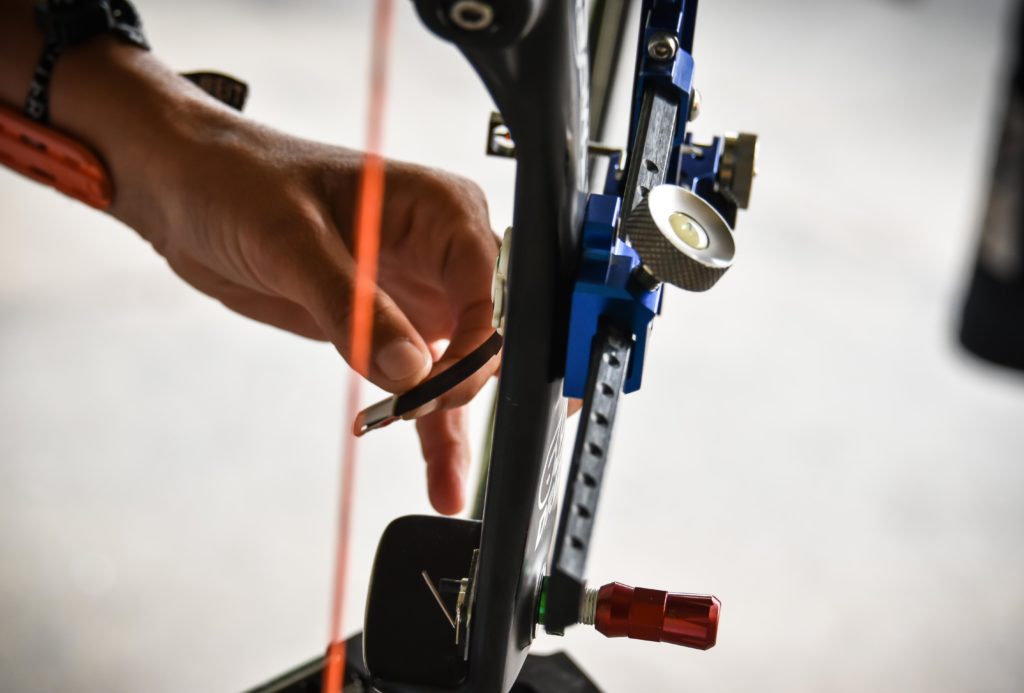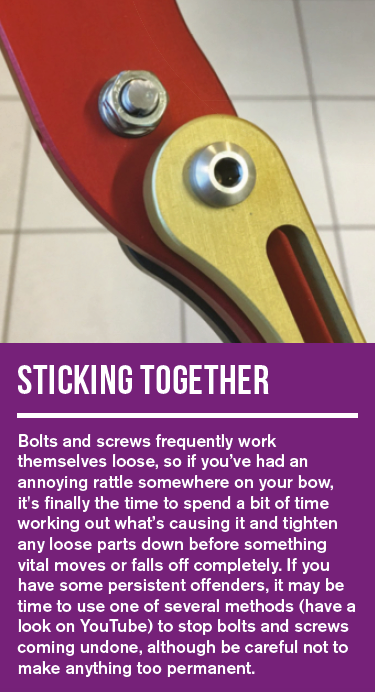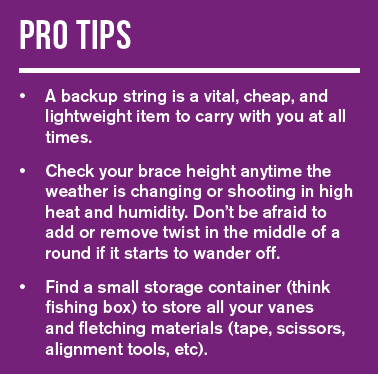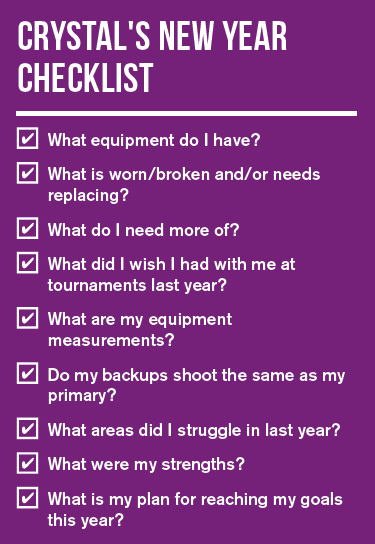
By Duncan Busby and Crystal Gauvin.
The New Year is a time for resolutions, but when it comes to archery the winter season can make even the most passionate of archers lose interest. Between the cold weather – and gluttony of food – it can be difficult to motivate yourself to shoot. So why not use this time to carry out some winter maintenance on your archery equipment instead?
Kit maintenance is vital; parts wear and spares get used, taking stock of your equipment and getting all those niggling jobs done now will make sure you’re ready for the New Year ahead.
Take stock
Looking back over your last season can help you to set goals and track your progress but it can also let you know where to make improvements to your equipment. Were your arrow groups so good that you got through all your spare nocks, pins and vanes? Did you shoot so much you’ve wore out your bow string? Were your arrows the right spine for your bow?
Topping up your spare equipment or investing in new products now will help you to improve in the coming months. You’ll be amazed just how quickly you can go through your nocks and there’s nothing worse than running out mid-shoot when you need them most. (Check our Ask The Experts column on Bow 130 for more on nocks). Knowing what you need to replace or repair now will save you a lot of bother further down the line and you never know, if you do it early enough you may even find yourself a bargain in the New Year sales.
Clear up
If a cluttered desk is a sign of a cluttered mind, what does your bow case say about you? If you’re anything like me a busy season will often mean things are randomly thrown back in without much thought. Organise your equipment; you might end up finding something you forgot you had or you may find out you’re in short supply of something you thought was plentiful. Sorting through your case and tool box now will ensure you don’t run out of or lose something vital later in the season. ‘A place for everything and everything in its place’ is absolutely true in archery. Are you following it every time?
Sell, Sell, Sell!
It’s very easy to hold on to equipment we no longer use; a good result or just good money spent can make a lot of us full-blown archery hoarders. So ask yourself: are you ever going to use that V-bar mount again? Do you really need your old arrow rest, now that you’ve replaced it with a nice new one? These items will often just end up gathering dust on a shelf, or worse, getting damaged in the bottom of your kit bag. So consider donating or selling any old bits you no longer use. Not only will you allow someone else to make good use of them, but you may even make back enough money to upgrade or re-stock your other equipment.
Have a Safe Flight
Your arrows are the single hardest working item of all your equipment; they take quite a bit of punishment (and damage, if your groups are nice and tight). Though it’s important to check them each time you shoot, the winter months can allow you to make a more detailed assessment of your arrows to ensure they’re still safe to use in the coming year.
So what should you be looking for? Whether you shoot all carbon, carbon-aluminium or pure aluminium arrows you should check for any cracks or dents in the shafts. Impacts in the target will weaken the arrow and can cause it to fly badly or even splinter when shot.
Spin each arrow by hand or use an arrow spinner; a bent shaft will not fly straight and consequently will not group with your other arrows. If you use carbon arrows flex the shaft to check for hidden cracks; hold each end of the arrow just below the point and the nock. Then gently flex the arrow away from you, putting at least one to two inches of deflection into the shaft. Listen out for any clicking or cracking noises, if you hear any discard the arrow: it’s damaged and it’s not safe to shoot. Don’t forget to rotate the arrow a few times and check it from every angle as some cracks can be very small and hard to detect.
Next check your points and nocks for any damage; points can be dented and nocks can be chipped or cracked by repeated impacts. If you’ve been using the same set of nocks for a while consider changing them for a new set; plastic nocks can become weak and misshapen over time, this can be fairly unnoticeable until they break or your groups begin to suffer.
If you use a pin nock system, remove the nocks and check the condition of the pins, look for any damage and spin the arrow to see if the pin is still straight. You’ll be surprised how easy it is to damage a pin and again it’s not always obvious to see. It’s important to replace a compromised arrow component as soon as you are aware of any damage; not only will this arrow affect your results, but it also may be dangerous to shoot.
Finally, have a look at your vanes; check to see if they are loose or damaged in any way. I can’t count the number of times I’ve seen one unstable vane cause an arrow to miss the target completely, so replace it with a brand new one if necessary.
Draw Attention to Your Bow
After a long outdoor (and/or indoor) season your bow may have travelled many miles and shot many arrows, in all kinds of weather. Now is the time to show some TLC to what can be a neglected and forgotten piece of equipment during the winter months.
Your strings and cables are a high wear and tear item. There is no set time to replace them as this depends on so many factors; such as how much you shoot, your strand count or string material and even the bow you use you use them on. The best advice is to replace them whenever they start to look shabby. It’s important to especially check areas where the string comes into conta
ct with cams and cable guards as this is where the most damage will occur. If the serving in these areas looks worn or damaged in any way it’s probably best to get a new set, or at the very least remove the serving, check the condition of the string underneath and then re-serve. Changing your strings now will give you plenty of time to shoot them in and re-tune your bow before the new outdoor season begins. 
Don’t forget to check the condition of your centre serving, nock point and D-loop as well; these are high friction areas and can wear surprisingly fast. There is nothing worse than a snapped D-loop or unravelled centre serving in the middle of a tournament, so replacing these now may save you a few points later.
A new year brings with it new goals, and while the aim of most archers remains the same, how we go about hitting our target can have the biggest impact on our chances of success. The focus is often on self-improvement, but this New Year try focusing on your equipment instead. You don’t always need to buy the newest or most expensive kit to achieve, sometimes putting extra effort and attention into what we already have can make the biggest difference; nobody likes to get to a tournament to find they have only five usable arrows.
Take an inventory
The first step in this process is to actually take inventory of what you have. Much like a company, it can be useful to make a list of every piece of equipment you have, as well as how many extras. For example, do you have two finger tabs? How about extra pieces of leather or spacers? Think about each piece of equipment you need to shoot in a tournament, including any pieces or parts of each item.
What about nocks? Do you have different colours, different styles? Do you have three extra packs or ten extra packs? The more specific you are the easier it is to spot holes, especially when talking about backups in case something would break.
As you go through your equipment to inventory it, you should also be checking everything for worn or broken pieces (think button on end of your plunger, broken strands in your string, etc). You don’t necessarily need to replace these things right now, but you should make note of them.
I also think this is a great time to take measurements and write down your entire equipment setup, so you know where your ending point was for the year. This should include things like; nock height, tiller, brace height, draw weight on fingers (arrows and limbs), stabiliser lengths and weights, etc. Again, the more detailed you can be the better for setting up any new equipment or making changes down the road.
Once you have taken stock of all your equipment, it is time to see what is missing and what you may need more of throughout the year. For example, if you typically re-fletch your dozen arrows nine times throughout the season, you would need 96 vanes, at the bare minimum, on hand. However, it’s always good practice to add a buffer to this number, as things happen. For example, maybe 120 vanes are a much safer bet for the year. You may not need this many, but it is much easier to plan ahead for the year and order everything you think you will need in advance. There is nothing worse than realising the night before a tournament that you only have five nocks left or your fletching glue has dried up. (You will also save a little on shipping charges for the year).

Take time to experiment
In addition, think of any new pieces of equipment you may want to experiment with (e.g. new leather for your finger tab, heavier limbs, or different indoor vanes). Many large archery supplies, like Lancaster Archery in the US, do free shipping and special deals at times if you spend a certain amount, or if you attend a trade fair at one of the big tournaments. If you have your list ready to go, it makes it easy to take advantage of these sales. When making your list, don’t forget items outside of your tradition “equipment list.” For example, do you have enough pairs of dress-code compliant shorts? What about sunscreen, an umbrella, or sun sleeves for those hot days in the sun? Do you have waterproof shoes? Think outside the box, and really expand your thinking about what you will need for the upcoming season.
The next step is to replace anything worn or broken, as well as cleaning your setup. Most modern archery equipment needs little more than a wipe with a cloth, but many times, especially if you enjoy shooting field archery, your bow will have sand or mud in some of the cracks. In addition, after shooting indoors for a while, many will find “target dust” collecting on and around their rest. Take your bow completely apart, checking the limbs, thoroughly cleaning the riser, and make sure everything is in good working order. Now is also a great time to put on a new string if you haven’t already during the indoor season.
 If you were unhappy with any of your equipment or you’d like to try something new, you can go ahead and make the swap at this point. From here you can begin setting up your bow to make sure the tune is still good with any changes you’ve made. Now is also a great time to verify your limb alignment and check your measurements still match what they were previously.
If you were unhappy with any of your equipment or you’d like to try something new, you can go ahead and make the swap at this point. From here you can begin setting up your bow to make sure the tune is still good with any changes you’ve made. Now is also a great time to verify your limb alignment and check your measurements still match what they were previously.
An area often forgotten, especially among newer archers, is to “shoot in” their backup equipment. Take your string for example. It is important that you have two identical strings. This means same material, same method of serving, same tension, etc. Ideally, you will want your strings to be the same colour as well, as the colour determines the wax content and can affect – just a very little – how the string shoots. Th e important thing is to shoot both strings and make sure you can swap them out without changing any part of your tune.
Another example is your tab. Many archers think if they buy two identical tabs that they will shoot the same, but this is simply not the case and could cost you valuable points in a tournament. Not only is it important to break in your backup tab, so the leather is worn evenly with your primary tab, but you should shoot them side by side. By doing this, you can learn the sight setting differences between the two, so in an emergency if you must grab your backup, you know exactly how many clicks to give your sight to hit the middle on your first arrow. I’ve seen top level archers, using identical tabs, hit in the white (1 or 2 ring) when switching between tabs.
Once you’ve gone through all these steps, you can feel good about your equipment and any supplies you may need. It is not time to turn your focus to yourself. If you haven’t already set your goals for the year, that should definitely be done at this point. It’s also a great time to look back through your archery journals or notebooks to see areas you struggled or did well with the previous year.
Using your goals as a guide, you can now start to address your areas of weakness from the previous season. Was there a particular aspect of your shot you struggled with? If so, then this can become a focus of your training or something you make sure to discuss with your coach. Did you make a note to increase your draw weight by a specific date this year? Th n now is the time to map out your path to getting there. Will you increase half of a pound every other week, will you do more reversals or other SPT work etc?
So this winter use your time wisely, and in between trips to the gym, give your archery kit the improvement it so desperately needs. You never know, it may be the best resolution you ever make.


